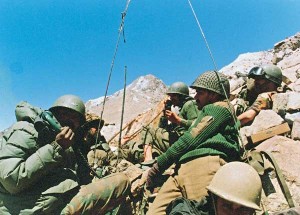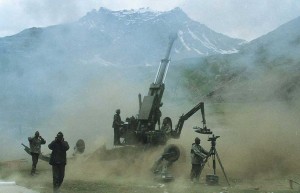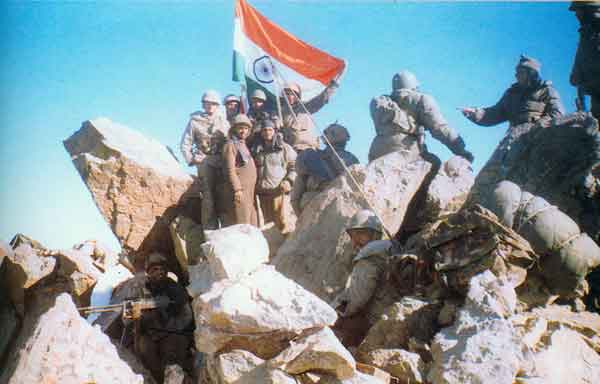Every military operation carries many lessons. The receptive imbibe some while the obstinate simply ignore. To be in a state of denial or finding alibis for mistakes rather than learn from failures can be counter productive. National war is a joint effort, not only by all the wings of the defence services, but equally involves civil administration and the nation at large.
In war no single service does favour to another in doing its designated duty as required of it. Any attempt to defend the indefensible invariably leads to irrelevant and specious arguments.
The article ‘Kargil Conflict, Sorry State of Higher Defence Management’ which appeared in the IDR of Oct–Dec 2009 issue highlighted failings at various levels in meeting Pakistani challenge at Kargil. There was hesitation, procrastination, and timidity in the Indian response. There are lessons to be learnt from this operation. Turning a Nelsons Eye will only result in repetition of these in future.
 The article ‘Kargil Controversy,’ essentially relied on the writings of the principal actors during the Kargil operations, discussions with those who took part in this operation and personal knowledge of ground etc. Air Marshal RS Bedi (Retd) in his article, ‘Kargil — an IAF perspective,’ in the IDR issue of Jan–Mar 2010, as rebuttal to the above article, is long on arguments but short on facts. He seems to prove the maxim that, ‘in war, truth is the first casualty.’It is no body’s case that the IAF did anything other than play a sterling role in free India’s wars, sans 1962 operations against China. During 1947 — 48 Kashmir War it did a commendable job. Yet no one can overlook the fact that it could carry just two companies of infantry (I Sikh) to Srinagar on the crucial first day and the other aircraft(s), carrying remaining components of the battalion, developed defect and landed at Jammu. Thus with just two companies, during the critical first day, the battalion had to calm the panic in Srinagar town, secure vital bridges, as well as hold in check the tribal hordes advancing on Srinagar airfield. This shortage of troops was part compensated by the commanding officer himself positioning with the company holding out against the tribal hordes and fell to their bullets.
The article ‘Kargil Controversy,’ essentially relied on the writings of the principal actors during the Kargil operations, discussions with those who took part in this operation and personal knowledge of ground etc. Air Marshal RS Bedi (Retd) in his article, ‘Kargil — an IAF perspective,’ in the IDR issue of Jan–Mar 2010, as rebuttal to the above article, is long on arguments but short on facts. He seems to prove the maxim that, ‘in war, truth is the first casualty.’It is no body’s case that the IAF did anything other than play a sterling role in free India’s wars, sans 1962 operations against China. During 1947 — 48 Kashmir War it did a commendable job. Yet no one can overlook the fact that it could carry just two companies of infantry (I Sikh) to Srinagar on the crucial first day and the other aircraft(s), carrying remaining components of the battalion, developed defect and landed at Jammu. Thus with just two companies, during the critical first day, the battalion had to calm the panic in Srinagar town, secure vital bridges, as well as hold in check the tribal hordes advancing on Srinagar airfield. This shortage of troops was part compensated by the commanding officer himself positioning with the company holding out against the tribal hordes and fell to their bullets.
Pakistan Air Force was half the size of IAF and yet Air Marshal Bedi seems worried stiff of the former doing damage to India.
During 1947–48 J&K operations the IAF was most ably led, by Air Commodore Mehar Singh, DFC. Lally Grewal’s landing at the hurriedly prepared, tiny runway to establish link with the besieged garrison at Poonch and Mehar Singh’s flight across un-chartered high Himalayan Ranges and landing his Dakota at the Leh polo ground at a height of approximately 11000 feet are landmark events in Indian aviation history. However, Air Marshal Bedi is completely wrong in his claim that the landing at Leh was on the riverbed. Leh polo ground was where the existing airfield is, while the river is some distance away.
The Pakistani offensive in Chamb Sector commenced at 0345 hrs on Sep 1, 1965 and not on Sep 5, 1965 as stated by Air Marshal Bedi. On Sep 1, the Army Chief left Srinagar for Delhi and asked for a meeting with the PM, RM and others, consequent to the Pakistan offensive in the Chamb Sector. The meeting was held in the AHQ (MO Directorate operations room) around mid-day of Sep 1, where, besides the PM and the RM, the other two Service Chiefs were also present. Like Kargil, at Chamb too, Pakistan had distinct tactical advantage.
 Lt Gen Harbaksh Singh, then GOC-in-C Western Command (West Com then included J&K as well) in his book, ‘War Dispatches’ at page 60 writes, “the Air Force responded promptly, but did little damage to the enemy except imposing caution — they instead took heavy toll of our own forces: all artillery ammunition vehicles and one armour ammunition vehicle were destroyed. Three AMX tanks and an armoured recovery vehicle were also damaged”. This action reflects total absence of joint training between the two services. Air Marshal Bedi appears to be ignorant of what actually happened in Akhnoor sector.
Lt Gen Harbaksh Singh, then GOC-in-C Western Command (West Com then included J&K as well) in his book, ‘War Dispatches’ at page 60 writes, “the Air Force responded promptly, but did little damage to the enemy except imposing caution — they instead took heavy toll of our own forces: all artillery ammunition vehicles and one armour ammunition vehicle were destroyed. Three AMX tanks and an armoured recovery vehicle were also damaged”. This action reflects total absence of joint training between the two services. Air Marshal Bedi appears to be ignorant of what actually happened in Akhnoor sector.
Air Vice Marshal Sondhi’s assessment of IAF’s performance in 1965 war at page 176 of ‘War Dispatches,’ reads, “…also exemplified Air Force’s own half hearted participation before the desperate reaction of the Pakistan Air Force which led to an all out air war. But the IAF missed a rare opportunity to demonstrate more fully to the Army that it exits, otherwise than a fighting service for its own good.” How Air Marshal Bedi has remained oblivious of these facts, only he can explain.
A good part of Indian Army has been deployed on high mountains for nearly half a century and the supporting air forces never worked out the ‘requisite measures’ to support it, leave aside practicing these and carrying out joint training!
Since full scale fighting across the LoC in J&K broke out in the third week of Aug 65, one expected the IAF to be at a high state of alert. Yet according to Bedi, (his article in HT dated Jun 21, 2004 refers) on Sep 2, 65 (even after having gone into action on Sep 1 at Chamb) IAF was caught unawares when the Pakistan Air Force struck, with devastating effect. According to the Air Marshall, Air Force requires sufficient notice to take necessary precautions to safeguard its assets. At Pathankot the aircraft were parked in one line, as if for inspection, instead of being dispersed or in their pens, with the result that in a single run these were destroyed/damaged by an enemy aircraft.
In his justification for the two weeks the IAF took to come on board at Kargil, Air Marshal contends that it did not want to expose its lack of preparedness as in 1965. One wonders how many in the IAF will support such a preposterous contention. If what he states is true then it reflects rather poorly at the state of readiness of our defence forces. While insistence of government clearance is understandable, the bogey of taking two weeks to ‘adopt requisite measures’ is untenable.
The Air Chief in his own article(s) unambiguously states what transpired during meeting with the RM, and later with the PM, on May 18 1999, where others too were present and with whom I have interacted. There was no mention of his wanting time to adopt requisite measures. He only talked of unsuitability of gunship helicopters for operations and escalation, incase fighters were used! His attitude is best reflected in his own writings, where he notes, “it (Kargil) was army’s problem,” “we know better,” and “to make up for the initial lapse, Army was now seeking Air Force help.” Pakistan Air Force was half the size of IAF and yet Air Marshal Bedi seems worried stiff of the former doing damage to India.
A good part of Indian Army has been deployed on high mountains for nearly half a century and the supporting air forces never worked out the ‘requisite measures’ to support it, leave aside practicing these and carrying out joint training! Air Marshal Bedi tells us that it was at the time of Kargil that the IAF ‘realised the challenge from this consternation to meet the seemingly impossible task.’
An increasing number of Air Force officers are veering to the view that the better weapon to use at Kargil was the attack helicopter. It is specious to argue that the Army is not aware of the full capabilities (limitations!) of the attack helicopter. These were integral to my Corps as far back as 1989–91. American experience of armed helicopter is altogether in a different context. Flying over areas occupied or where there are insurgents on the ground, helicopters are unduly exposed to small arms fire. At Kargil the ground situation was altogether different where even stinger missile launchers could be neutralized by artillery fire during the period the armed helicopters engaged enemy positions. Gunship helicopters adopt appropriate tactics to limit their exposure to enemy weapons and in addition have their own defence mechanism against missile attack. All this merely reflects lack of understanding of the nature of ground battle and full potential of different weapon systems by the Air Marshal.
Enemy had occupied features on the ridgelines, well away from the LoC and there was no chance of own fighters straying into PoK. When fighter aircraft did finally go into action, they did not stray across the LoC. Admittedly there were the limitations on the ‘fly path’ of aircraft as these attacked targets.
…if close air support for ground battle is least preferred by the IAF, then squadrons authorized for ground support role need to be turned over to Army Aviation.
The contention that once the Army acquired armed helicopters, it did not want close air support from the IAF is a figment of the Air Marshal’s own imagination on the one hand and on the other, shows lack of understanding of the full spectrum of close air support. Out of 45 squadrons of the IAF, X number are authorized for close air support. So for any one to contend that close air support to the ground battle is the most inefficient utilization of air power and least preferred option for the IAF is preposterous. Such a view betrays lack of understanding of ground battle and the important role close air support plays in it. At the same time if close air support for ground battle is least preferred by the IAF, then squadrons authorized for ground support role need to be turned over to Army Aviation.
In response to the article ‘Kargil Controversy,’ (IDR Oct–Dec 2009) the author received emails from two Air Marshals. One of them noted that ‘it was the Chief Minister of Bengal who advised Nehru against using IAF because Chinese Air Force would bomb cities in his province,’ while the second Air Marshal revealed that Nehru asked USA to send X number of fighter squadrons and transport aircraft to help India. Whereas, Air Marshal Bedi tells us that it was the American Ambassador in Delhi who advised Nehru against using IAF in this war! What is of relevance is the advice, if any, the Air Chief gave to Nehru! No one seems to educate us on this vital input!
While Pakistani troops occupied the heights, along the 160 Km frontage at Kargil, no guns were deployed forward of the LoC. Also each forward position was provided logistic support from the rear across the LoC as there were no laterals. Therefore, there was no requirement to create a central logistic base to support a group of posts. Consequently, there was no worthwhile logistic base across the LoC to target. Those of us who have seen the film of own aircraft targeting the, so called storage dump at Muntho Dhalo can only laugh at the claim that this attack was the turning point in the Kargil battle. Why not screen this film at the training institutes, units/formations and spread the laughter!
It is our contention that both artillery and air support at Kargil, because of the nature of terrain and other constraints, could not be very effective. Against Tiger Hill army deployed 120 field/medium guns, 122 mm multi-barrelled Grad rocket launchers, and motars, (figures from the Army Chief’s book, ‘From Surprise to Victory’ page 170.) Air Marshal Bedi claims that ‘Tiger Hill was literally flattened’ by the Air Force and Air Commodore Jasjit Singh concludes that thereafter it was ‘a cake walk’ for the attacking troops. However, these claims sound hollow in the face of casualties our troops suffered in capturing this feature. Of the two battalions that attacked Tiger Hill, 8 Sikh suffered, 35 dead, which included 1 officer and 4 JCOs and 150 wounded. The second battalion, 22 Grenadiers, lost 2 officers, 3 JCOs and 29 ORs and like 8 Sikh, had equally large numbers in wounded. Some, flattening of Tiger Hill and what a cakewalk there after!
We are indeed proud of the outstanding performance of the IAF both in peace and war. At Longewala it set a new bench mark in ground support missions. It has the most skilful and daring pilots who have time and again proved their mettle. Their exuberance and enthusiasm to get to grips with the enemy is unmatched. It is the higher defence set up that displayed uncalled for hesitancy in committing these daredevils to battle at Kargil.
Air Force in ground support role is a very potent weapon and can turn the tide in battle. The dynamics of a short war does dictate the imperatives of putting greater weight of air effort to support ground battle in all its facets. There is a compelling need for evolving acceptable tactical and strategic concepts for employment of various wings of the defence forces, in the context of a short war and synergizing their combat potential. Regular joint training for smooth functioning and for each service to understand the strengths and limitations of the other two, is essential. However, in the absence of unity of command much of this is likely to remain on paper.






It is shoking to hear the fact and the glorified claims done by IAF’s ranked and decorated officer’s.. ‘Air Marshal Bedi and Air Commodore Jasjit Singh concluding that thereafter it was ‘a cake walk’’ .. can’t really imagine exactly WHO they were making this cake for..
without knowing or accepting the fact and damge happened on ground.. Downplaying and tapping own’s back, (like most of Time done by our own political / administrative brigade of Babus)..
i have to ask myself.. was it was really a Trained and Professionals work??.. hard to say..
Dont shoot the messenger. In this case the broad term ‘IAF’ is the messenger. It did its task assigned, the authority, decision maker , procrastinator was the air chief!. It was not the IAF’s failure but her chief’s failure ( if that be).
Like wise and Having said this the sentence by the Chief of the army ‘ I didn’t shorten my trip as no one asked me to” shows that both the chiefs were sailing in the same boat. Both Could not and were not prepared for a surprise attack. An alert reaction from both was ‘to stay away”! Probably the trend of ‘ yes sir 3 bags full sir’ whilst talking to IAS Babus and politicians blunted what is called’ fast on the up take’..
Malik’s statement that he was not aware of Indians border being mutilated and his soldiers being killed portrays the chief’s lack of interest in his own job, one cannot fault the entire army for that. Would the chief’s carelessness in this case amount for an article ridiculing the army thus ridiculing those who were sent to get shot at thru a frontal attack!!!
When the blame is squared on a broader term like the IAF or the Navy or the army, psychologically then all the ranks in the varied uniform join in to segment the rift further by the good intention of standing by their force.